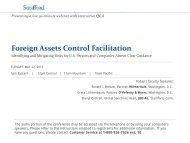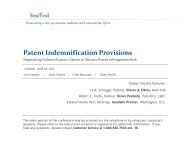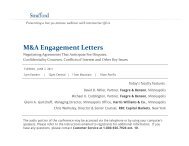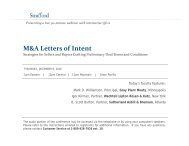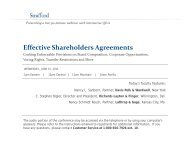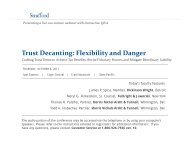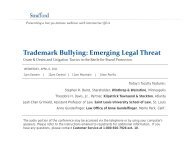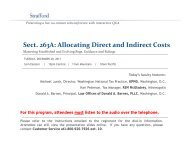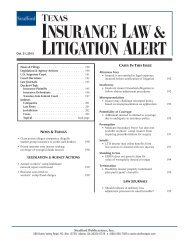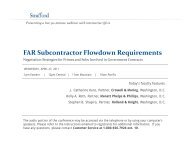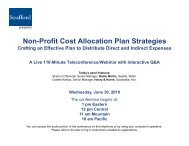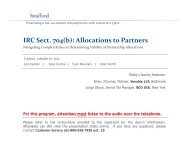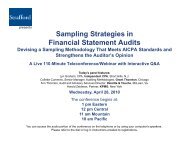Obviousness Standard for Patents - Strafford
Obviousness Standard for Patents - Strafford
Obviousness Standard for Patents - Strafford
Create successful ePaper yourself
Turn your PDF publications into a flip-book with our unique Google optimized e-Paper software.
Presenting a live 90-minute webinar with interactive Q&A<br />
<strong>Obviousness</strong> <strong>Standard</strong> <strong>for</strong> <strong>Patents</strong><br />
Approaches to Withstand USPTO <strong>Obviousness</strong> Rejections and Attacks on Patent Validity<br />
TUESDAY, JANUARY 31, 2012<br />
1pm Eastern | 12pm Central | 11am Mountain | 10am Pacific<br />
Today’s faculty features:<br />
Paul Davis, Partner, Goodwin Procter, Menlo Park, Calif.<br />
Scott J. Szala, Partner, Winston & Strawn, Chicago<br />
Thomas L. Irving, Partner, Finnegan Henderson Farabow Garrett & Dunner, Washington, D.C.<br />
The audio portion of the conference may be accessed via the telephone or by using your computer's<br />
speakers. Please refer to the instructions emailed to registrants <strong>for</strong> additional in<strong>for</strong>mation. If you<br />
have any questions, please contact Customer Service at 1-800-926-7926 ext. 10.
FOR LIVE EVENT ONLY<br />
For CLE purposes, please let us know how many people are listening at your<br />
location by completing each of the following steps:<br />
• In the chat box, type (1) your company name and (2) the number of<br />
attendees at your location<br />
• Click the word balloon button to send
Sound Quality<br />
If you are listening via your computer speakers, please note that the quality of<br />
your sound will vary depending on the speed and quality of your internet<br />
connection.<br />
If the sound quality is not satisfactory and you are listening via your computer<br />
speakers, you may listen via the phone: dial 1-866-328-9525 and enter your PIN<br />
when prompted. Otherwise, please send us a chat or e-mail<br />
sound@straf<strong>for</strong>dpub.com immediately so we can address the problem.<br />
If you dialed in and have any difficulties during the call, press *0 <strong>for</strong> assistance.<br />
Viewing Quality<br />
To maximize your screen, press the F11 key on your keyboard. To exit full screen,<br />
press the F11 key again.
THE FEDERAL<br />
CIRCUIT’S EVOLVING<br />
OBVIOUSNESS<br />
ANALYSIS<br />
Paul Davis<br />
Partner<br />
PDavis@goodwinprocter.com<br />
650.752.3106 (Menlo Park)<br />
858.202.2700 (San Diego) ©2012. Goodwin Procter LLP
THE FEDERAL CIRCUIT’S<br />
EVOLVING OBVIOUSNESS<br />
ANALYSIS<br />
• The Federal Circuit continues to take some of<br />
the bite out of the Supreme Court‟s KSR<br />
decision (KSR Int’l Co. v. Teleflex Inc., 550 U.S.<br />
398, 418 (2007)) that broadened the basis <strong>for</strong><br />
determining that patent claims are obvious by,<br />
among other things, avoiding overly rigorous<br />
application of the TSM (teaching, suggestion,<br />
motivation) test.<br />
5
NEED A TITLE<br />
Unigene Labs. and Upsher-Smith Labs.<br />
v. Apotex (Fed. Cir. August 25, 2011)<br />
• The Federal Circuit continued to develop law on obviousness in<br />
view of KSR.<br />
• In the chemical arts, the court tends to apply a modified TSM<br />
analysis.<br />
• The Federal Circuit held that use of 20 mM citric acid as an<br />
absorption-enhancing agent and surfactant in a nasal spray<br />
composition was not obvious.<br />
6
NEED A TITLE<br />
• The Federal Circuit acknowledged that KSR broadly held that the motivation<br />
to combine references.<br />
1. The court uses a “reference composition” <strong>for</strong> the first time in looking at<br />
obviousness of a <strong>for</strong>mulation.<br />
• The court broadens its use in the chemical and medical fields.<br />
2. The purpose of citric acid is not identified in the claim, although it was<br />
defined during prosecution as being significant.<br />
• This opinion can serve as a reminder that reciting the purpose or advantage<br />
is not required in the claim.<br />
3. In its prior art analysis, the court takes a hard look <strong>for</strong> a suggestion,<br />
motivation or teaching to combine references.<br />
• The court recognized that the desire to create a <strong>for</strong>mulation that is<br />
bioequivalent to an existing <strong>for</strong>mulation provides motivation to develop new<br />
<strong>for</strong>mulations.<br />
7
Motivation to Combine<br />
Wyers v. Master Lock Co., 616 F.3d 1231 (Fed. Cir. 2010<br />
• In Wyers the Federal Circuit found that even in the<br />
absence of expert testimony, judges can make a common<br />
sense determination to combine the prior art to find patent<br />
claims obvious and thus invalid.<br />
• On February 22, 2011, the Supreme Court declined to<br />
grant Wyers‟ petition <strong>for</strong> a writ of certiorari.<br />
• The Federal Circuit reversed, holding that it was a matter<br />
of common sense to combine the prior art under KSR as<br />
a matter of law.<br />
8
Motivation to Combine<br />
(cont)<br />
• The Federal Circuit addressed three primary issues:<br />
1. Whether the prior art references were within the same<br />
field of endeavor;<br />
2. Whether there was a motivation to combine the prior<br />
art references, and<br />
3. Whether secondary considerations existed and were<br />
significant.<br />
• Judge Linn concurred, and wrote separately.<br />
9
Motivation to Combine<br />
(cont)<br />
• In Tokai Corp. v. Easton Enterprises, Inc.,—F.3d—, 2011 WL 308370<br />
(Fed. Cir. 2011)<br />
• In Tokai the Federal Circuit again affirmed a grant of summary judgment in<br />
the trial court which found the patents-in-suit to be invalid as obvious.<br />
• Tokai‟s March 3, 2011 petition <strong>for</strong> panel rehearing and rehearing en banc is<br />
currently pending as of this writing.<br />
• Tokai‟s patents related to safety utility lighters with extended lighting rods,<br />
used <strong>for</strong> barbecue grills, <strong>for</strong> example.<br />
• The district court declined to consider Tokai‟s expert declarations granted<br />
Easton‟s motion <strong>for</strong> summary judgment and concluded that the patents were<br />
invalid as obvious, based on the Graham factors because Tokai failed to<br />
submit written reports during discovery, thereby failing to give Easton an<br />
opportunity to depose the experts.<br />
10
The Federal Circuit’s<br />
Decision<br />
• The panel issued a split decision affirming the court below.<br />
• Judge Lourie stated that courts “may find a motivation to<br />
combine prior art references in the nature of the problem to be<br />
solved.”<br />
• The Court relied on Tokai‟s admission “„the components<br />
required to assemble the claimed inventions are “simple<br />
mechanical parts that are well known in the art.‟”<br />
• Judge Newman, disagreeing with the majority that the invention<br />
was the result of combining previously existing inventions,<br />
described Tokai‟s utility rod lighter as “ingenious,” “having a<br />
novel safety mechanism that achieves a new level of childsafety<br />
over the prior art.”<br />
11
Impact of Wyers and Tokai<br />
• These decisions support a summary judgment strategy <strong>for</strong> invalidity claims in<br />
three ways:<br />
1. By making it easier to find a motivation to combine;<br />
2. By not requiring expert testimony to establish a motivation to combine and,<br />
3. In cases where a strong prima facie case of obviousness is established, by<br />
making it difficult <strong>for</strong> secondary considerations to save the patents.<br />
• Wyers provides federal judges with some confidence to invalidate patents using<br />
common sense as the motivation to combine prior art references.<br />
• Tokai makes it more challenging <strong>for</strong> a simple mechanical patent to withstand an<br />
obviousness challenge.<br />
• In Tokai, the Federal Circuit may have been influenced by the simplicity of the<br />
invention.<br />
12
Impact of Wyers and Tokai<br />
(cont)<br />
• In re Klein reversed the Patent Office‟s rejection of a hummingbird nectar mixer<br />
based on non-analogous art.<br />
• The Court found that the five references were inappropriately used by the Patent<br />
Office because they were not analogous art and there<strong>for</strong>e not prior art under §103.<br />
• The Court noted that “[a] reference qualifies as prior art <strong>for</strong> an obviousness<br />
determination under § 103 only when it is analogous to the claimed invention.”<br />
• There are two separate tests <strong>for</strong> determining what defines the scope of analogous<br />
art:<br />
• “Whether the art is from the same field of endeavor, regardless of the problem<br />
addressed” and;<br />
• “If the reference is not within the field of the inventor‟s endeavor, whether the<br />
reference still is reasonably pertinent to the particular problem with which the<br />
inventor is involved.”<br />
• The Court reversed the Patent Office‟s finding of obviousness and remanded <strong>for</strong><br />
further consideration.<br />
13
NEED A TITLE<br />
Western Union Co. v. MoneyGram Payment Systems, Inc., Nos. 10-1080, -<br />
1210 (Fed. Cir. Dec. 7, 2010)<br />
• The Federal Circuit reversed the jury‟s determination that the patents-in-suit<br />
were not invalid <strong>for</strong> obviousness.<br />
• At trial, a jury determined that MoneyGram‟s original and redesigned systems<br />
infringed Western Union‟s money transfer patents.<br />
• On appeal, the Federal Circuit first considered the district court‟s denial of<br />
MoneyGram‟s renewed motion <strong>for</strong> JMOL.<br />
• The Federal Circuit turned next to the merits of MoneyGram‟s obviousness<br />
argument.<br />
• The Court agreed with MoneyGram that the money transfer patents are<br />
obvious.<br />
14
NEED A TITLE (cont)<br />
• The Federal Circuit concluded that, based on this evidence, no reasonable jury<br />
should have found that MoneyGram failed to present sufficient evidence to<br />
demonstrate that electronic transaction devices were commonplace in the art<br />
at the time of the invention.<br />
• The Court specifically concluded that it would not have been difficult at the<br />
time of the invention <strong>for</strong> a person of ordinary skill in the art to integrate an<br />
electronic transaction device that was available from Western Union itself into<br />
a well-known money transfer system that was also owned by Western Union.<br />
• The Court then addressed whether the use of a code as part of a <strong>for</strong>mless<br />
money transfer was obvious.<br />
• Finally, the Court concluded that the district court erred in its heavy reliance on<br />
secondary considerations in denying MoneyGram‟s JMOL of obviousness.<br />
• The Federal Circuit reminded that the patentee must establish a nexus<br />
between evidence of commercial success and the patented invention.<br />
15
Applying the USPTO Examination<br />
Guidelines in Patent Prosecutions<br />
Post-KSR<br />
© 2012 Winston & Strawn LLP<br />
Scott Szala<br />
Winston & Strawn LLP<br />
35 W. Wacker Drive<br />
Chicago, IL 60601<br />
(312) 558-5875<br />
sszala@winston.com
KSR Int'l Inc. v. Teleflex, Inc.,<br />
550 U.S. 398 (2007)<br />
• Pre-KSR, the courts considered the teaching, suggestion, and<br />
motivation ("TSM") test in determining "obviousness." 35 U.S.C<br />
§103.<br />
• In KSR, the Supreme Court rejected an obviousness analysis that<br />
was limited to using the TSM test in an "overly rigid and <strong>for</strong>malistic<br />
way."<br />
• KSR reaffirmed the use of the Graham v. John Deere Co., 383 U.S.<br />
1 (1966) factors to determine obviousness, including: (1) the scope<br />
and content of prior art; (2) the differences between the claimed<br />
invention and prior art; and (3) the level of ordinary skill in the art.<br />
• Post-KSR, the courts consider obviousness based upon the<br />
predictability of the invention and whether a person of ordinary skill<br />
in the art ("POSITA") would reasonably expect to arrive successfully<br />
at the claimed invention based upon the teachings of the prior art<br />
references.<br />
© 2012 Winston & Strawn LLP<br />
17
Sources of In<strong>for</strong>mation Regarding<br />
"<strong>Obviousness</strong>"<br />
• 35 U.S.C. 103<br />
• www.uspto.gov<br />
• Manual of Patent Examining Procedures (MPEP) (8 th ed.<br />
2001, revised July 2010), 2141<br />
• 72 Fed. Reg. 57526 (10/10/07)<br />
• 75 Fed. Reg. 53643 (9/1/10)<br />
• 324 OG (11/6/07)<br />
• 1358 OG (9/28/10)<br />
• Karen Canaan, Canaan Law, P.C., Menlo Park, CA<br />
(1/12/11 Straf<strong>for</strong>d Seminar)<br />
© 2012 Winston & Strawn LLP<br />
18
Post-KSR Examination<br />
• Post-KSR Changes To USPTO <strong>Obviousness</strong> Examinations<br />
• The TSM standard no longer controls.<br />
• Examination of prior art searches is not limited to the problem<br />
sought to be solved by the invention.<br />
• The USPTO per<strong>for</strong>ms obviousness examinations under its seven<br />
(7) post-KSR promulgated guidelines (Guidelines A to G).<br />
• Common sense and creativity will be considered.<br />
• "Teaching away" from the invention will be considered.<br />
• Unexpected results and extraordinary skill will be considered.<br />
• Non-analogous art in other fields will be considered.<br />
• "Obvious-to-try" is now a valid ground <strong>for</strong> a rejection.<br />
© 2012 Winston & Strawn LLP<br />
19
PTO OFFICE ACTION<br />
• When considering the first Graham factor -- determining the scope and<br />
content of prior art -- the PTO reviews the specifications and claims and<br />
understands what the applicant actually invented. The content of prior<br />
art is determined at the time of the invention was made to avoid<br />
hindsight. Analogous prior art from a different field will be considered.<br />
• As to the second Graham factor, the PTO ascertains the difference<br />
between the claimed invention and the prior art. The claimed invention<br />
is generally to be viewed as a whole, but can be distilled down to the<br />
"gist" or "thrust" to avoid the general rule. Prior art must be considered<br />
in its entirety, including that which "teaches away."<br />
• When considering the third factor -- resolving the level of ordinary skill<br />
in the art -- the PTO considers: the types of problems encountered in<br />
the art; prior art solutions to those problems; the rapidity in which the<br />
invention was made; the sophistication of the technology; and the<br />
educational level of active workers in the field. Ascertaining the level of<br />
ordinary skill is necessary to maintain objectivity.<br />
© 2012 Winston & Strawn LLP<br />
20
Examination Guideline A (2007):<br />
"Combinations"<br />
• <strong>Obviousness</strong> can be found by combining prior art elements<br />
according to known methods to yield predictable results:<br />
• If the Graham factors so indicate;<br />
• If all prior art of claimed elements, not in combination, must be<br />
collectively considered;<br />
• If a POSITA would have combined the claimed elements under the<br />
known methods and, if in combination, each element would have<br />
per<strong>for</strong>med the same function as if per<strong>for</strong>med separately; and<br />
• If a POSITA would have recognized the combination results as<br />
predictable is considered.<br />
• Under the first guideline factor, the reasons why the POSITA<br />
would combine the elements in the way that the claimed new<br />
invention does should be explicitly stated. If the prior art<br />
"teaches away" from a combination, then nonobviousness is<br />
found.<br />
© 2012 Winston & Strawn LLP<br />
21
Examination Guideline B:<br />
"Substitution"<br />
• Simple substitution of one known element <strong>for</strong> another to obtain<br />
predictable results can render a patent obvious:<br />
• If the prior art contained a device (method, product, etc.), which differed<br />
from the claimed device by the substitution of some components (step,<br />
element, etc.) with other components;<br />
• If the substituted components and their functions were known in the art;<br />
• It POSITA could have substituted one known element <strong>for</strong> another and the<br />
results of the substitution would have been predictable; and<br />
• If the Graham factors so indicate.<br />
• The second examination guideline considers whether an element<br />
from a secondary reference is substituted into the teaching from the<br />
primary reference to determine obviousness, even where no<br />
suggestion in the latter exists.<br />
• An obviousness finding only requires a reasonable expectation of<br />
successful, not an absolute predictability of success.<br />
© 2012 Winston & Strawn LLP<br />
22
Examination Guideline C:<br />
"Similar Device Improvement"<br />
• Use of a known technique to improve similar devices (methods or<br />
products) in the same way can result in obviousness.<br />
• If the prior art contained a "base" device (method or product) upon which<br />
the claimed invention can be seen as an "improvement;"<br />
• If the prior art contained a "comparable" device (method, or product that is<br />
not the same as the base device) that was improved in the same way as the<br />
claimed invention;<br />
• If the POSITA could have applied the known "improvement" technique in<br />
the same way to the "base" device (method, or product) and the results<br />
would have been predictable to one of ordinary skill in the art; and<br />
• If the Graham factors so indicate.<br />
• The third examination guideline whether the improvement relating to<br />
the invention is within the skill level of the POSITA. If the application<br />
of the technique is beyond the skill level of the POSITA, then the<br />
technique is not obvious.<br />
© 2012 Winston & Strawn LLP<br />
23
Examination Guideline D:<br />
"Improvements"<br />
• Applying a known technique to a known device (method or<br />
product) ready <strong>for</strong> improvement to yield predictable results will<br />
result in an obviousness finding:<br />
• If the Graham factors are met;<br />
• If the prior art contained a "base" device (method, or product) upon<br />
which the claimed invention can be seen as an "improvement";<br />
• If the prior art contained a "known technique" that is applicable to<br />
the base device (method or product);<br />
• If a POSITA would have recognized that applying the known<br />
technique would have yielded predictable results and resulted in an<br />
improved system; and<br />
• If any other relevant factors so indicate.<br />
• The fourth examination guideline considers that if a particular<br />
recognized technique is recognized as part of the ordinary<br />
capabilities of a POSITA, obviousness can be found.<br />
© 2012 Winston & Strawn LLP<br />
24
Examination Guideline E:<br />
"Obvious to Try"<br />
• Choosing from a finite number of identified, predictable solutions, with a<br />
reasonable expectation of success will be deemed obvious:<br />
• If the Graham factors are met;<br />
• If at the time of the invention, a recognized problem or need in the art existed, which may<br />
have included a design need or market pressure to solve a problem;<br />
• If a finite number of identified, predictable potential solutions to the recognized need or<br />
problem existed;<br />
• If a POSITA could have pursued the known potential solutions with a reasonable expectation<br />
of success; and<br />
• If any other relevant factors so indicate.<br />
• The fifth "obvious to try" examination guideline addresses whether a POSITA<br />
would have pursued the known options within his technical grasp. If this leads<br />
to anticipated success, then it is likely the product was not of innovation, but of<br />
ordinary skill and common sense. Thus, a combination that was "obvious to try"<br />
can be deemed obvious.<br />
• The unpredictability of a procedure may be obviated when only a "finite" number<br />
of solutions to solve a problem exist and the testing of the solutions is within the<br />
skill level of a POSITA.<br />
© 2012 Winston & Strawn LLP<br />
25
Examination Guideline F:<br />
"Analogous Fields"<br />
• Known work in one field of endeavor may prompt variations of it <strong>for</strong> use<br />
in either the same field or a different one based on design incentives or<br />
other market <strong>for</strong>ces if the variations would have been predictable to a<br />
POSITA:<br />
• If the Graham factors are met;<br />
• If the scope and content of the prior art, whether in the same field of endeavor as<br />
that of the applicant's invention or a different field of endeavor, included a similar<br />
or analogous device (method or product);<br />
• If design incentives or market <strong>for</strong>ces existed that would have prompted<br />
adaptation of the known device (method, or product);<br />
• If the differences between the claimed invention and the prior art were<br />
encompassed in known variations or in a principle known in the art;<br />
• If a POSITA, in view of the identified design incentives or other market <strong>for</strong>ces,<br />
could have implemented the claimed variation of the prior art, and the claimed<br />
variation would have been predictable to one of ordinary skill in the art; and<br />
• If any other relevant factors so indicate.<br />
• The sixth examination guideline considers whether a POSITA would<br />
vary the prior art in a predictable manner to result in the claimed<br />
invention.<br />
© 2012 Winston & Strawn LLP<br />
26
Examination Guideline G:<br />
"TSM"<br />
• Some teaching, suggestion, or motivation in the prior art that<br />
would have led one of ordinary skill to modify the prior art<br />
reference or to combine prior art reference teachings to arrive<br />
at the claimed invention can result in an obviousness finding:<br />
• If the Graham factors are met;<br />
• If some TSM existed, either in the references themselves or in the<br />
knowledge generally available to a POSITA, to modify the<br />
references or to combine reference teachings;<br />
• If a reasonable expectation of success existed; and<br />
• If other relevant factors so indicate.<br />
• The seventh examination guideline considers the use of the<br />
TSM test in obviousness determinations, and stresses that<br />
TSM must be flexible and that no explicit suggestion to<br />
combine is necessary.<br />
© 2012 Winston & Strawn LLP<br />
27
Office Action Rejection And The Applicant's<br />
Reply and Rebuttal Evidence.<br />
• If the PTO establishes the Graham factors and makes a prima facie case of<br />
obviousness, the burden then shifts to the applicant: (1) to show the PTO erred;<br />
or (2) to provide other evidence to show that the claimed subject matter is<br />
nonobvious. Mere arguments or conclusory statements will not meet the<br />
applicant's burden of proof. The applicant has a right to reply and to submit<br />
rebuttal evidence.<br />
• Although the Guidelines are not dispositive, they carry substantial weight and<br />
the applicant should carefully review whether the Examiner properly applied the<br />
law and/or the appropriate Examination Guideline to the facts. The PTO is<br />
supposed to give a "reasoned explanation <strong>for</strong> every obviousness rejection."<br />
• A proper response should address erroneous statements and citations and<br />
additional legal authorities, where appropriate, should be cited (e.g., evidence or<br />
case law addressing non-known problems, teaching away, unexpected results,<br />
hindsight reconstruction). Other responses included: a POSITA would not have<br />
combined the claimed elements by known methods; the combined elements do<br />
not per<strong>for</strong>m the function that each element per<strong>for</strong>ms separately, and the results<br />
of the claimed combination were unexpected.<br />
© 2012 Winston & Strawn LLP<br />
28
Unknown Problem –<br />
Examination Guideline A (2010)<br />
• In re Omeprazole Patent Litigation, 536 F.3d 1361 (Fed. Cir.<br />
2008) (Example 4.1).<br />
• Although a general method could have been applied to make the<br />
claimed product known and was within the skill level of the POSITA,<br />
the claim was held to be nonobvious when the problem which had a<br />
suggested use of the method had been previously unknown.<br />
• The applicant applied an enteric coating to the drug omeprazol to<br />
avoid having the bill disintegrate be<strong>for</strong>e reaching the intended site.<br />
• Although the enteric coatings were known, the coating under prior<br />
art was interfering with the action of the drug.<br />
• Federal Circuit affirmed the district court finding that the patent was<br />
nonobvious because the problem that the invention addressed was<br />
not previously known so there was no reason <strong>for</strong> a POSITA to add<br />
the enteric layer.<br />
© 2012 Winston & Strawn LLP<br />
29
"Teaching Away"<br />
Examination Guideline A<br />
• Crocs, Inc. v. U.S. International Trade Commission, 598<br />
F.3d 1294 (Fed. Cir. 2010) (Example 4.2)<br />
• A claimed combination of prior art elements was nonobvious<br />
since the prior art teaches away from the claimed combination<br />
and the combination yielded no more than predictable results.<br />
• The case involved Crocs footwear and its one-piece foam<br />
base <strong>for</strong> the top part of the shoe and a strap to provide<br />
Achilles' support on the lower portion of the shoe.<br />
• The Federal Circuit reversed the finding of the International<br />
Trade Commission and held that the prior art taught against<br />
using foam as a material <strong>for</strong> the heel strap, so the results<br />
were not predictable, and thus, nonobvious.<br />
© 2012 Winston & Strawn LLP<br />
30
Teaching Away 1 –<br />
Examination Guideline B<br />
• Eisai Co. Ltd. v. Dr. Reddy's Labs (Fed. Cir. 2008)<br />
(Example 4.11).<br />
• A claimed compound was nonobvious where no reason<br />
existed to modify the closest prior art lead compound to obtain<br />
the claimed compound and prior art taught that modifying it<br />
would destroy its advantageous property.<br />
• Rabeprazole, a proton pump inhibitor <strong>for</strong> treating stomach<br />
ulcers and related disorders, was the product at issue.<br />
• The Federal Circuit affirmed the district court grant of<br />
summary judgment that despite structural similarities of<br />
certain products, no reason existed <strong>for</strong> a POSITA to modify<br />
the lead compound.<br />
© 2012 Winston & Strawn LLP<br />
31
Teaching Away 2 –<br />
Examination Guideline A<br />
• Example 4.6. DePuy Spine, Inc. v. Medtronic Sofamor Danek, Inc.,<br />
567 F.3d 1314 (Fed. Cir. 2009) (Example 4.6).<br />
• Predictability as discussed in KSR encompasses the expectation the<br />
prior art elements are capable of being combined, as well as the<br />
expectation that the combination would have worked <strong>for</strong> its intended<br />
purpose. An inference that a claimed combination would not have been<br />
obvious is especially strong where the prior art‟s teachings undermine<br />
the very reason being proffered as to why a person of ordinary skill<br />
would have combined the known elements.<br />
• The invention was a screw used in spinal surgeries that included a<br />
compression member <strong>for</strong> pressing a screw head against a receiver<br />
member.<br />
• The Federal Circuit that prior art (Puno) taught way from the<br />
combination because a rigid screw increases the likelihood that the<br />
screw will fail within the human body rendering the device inoperative.<br />
Secondary considerations relating to the failure of others and copying<br />
also supported the finding that the combination was not obvious.<br />
© 2012 Winston & Strawn LLP<br />
32
Ordinary, not Extraordinary Skill –<br />
Examination Guideline C<br />
• Factors pertinent to the level of skill element of the Graham<br />
obviousness analysis include (1) educational level of the<br />
inventor, (2) type of problems encountered in the art, (3) prior<br />
art solutions to those problems, (4) rapidity with which<br />
innovations are made, (5) sophistication of the technology,<br />
and (6) education level of workers active in the field.<br />
Environmental Design, Ltd. v. Union Oil Co. of Calif. , 713<br />
F.2d 693 (Fed. Cir. 1983).<br />
• A person of ordinary skill in the art is "one who thinks along<br />
the line of conventional wisdom in the art and is not one who<br />
undertakes to innovate ... " <strong>Standard</strong> Oil Co. v. American<br />
Cyanamid Co. , 774 F.2d 448 (Fed. Cir. 1985).<br />
• "A person of ordinary skill is also a person of ordinary<br />
creativity, not an automaton." KSR, 550 U.S. 398,421 (2007).<br />
© 2012 Winston & Strawn LLP<br />
33
Common Knowledge Assertions –<br />
Examination Guideline D<br />
• Where an Examiner chooses to take notice of facts beyond the<br />
record <strong>for</strong> the prima facie case, those facts must be "capable of such<br />
instant and unquestionable demonstration as to defy dispute." In re<br />
Alhert, 424 F.2d 1088, 1091 (CCPA 1970). It is not appropriate <strong>for</strong><br />
an Examiner to take official notice of facts without citing a prior art<br />
reference where the facts asserted to be well-known are not capable<br />
of instant and unquestionable demonstration as being well-known.<br />
Id. Assertions of technical facts in esoteric technology or specific<br />
knowledge of the prior art must always be supported by citation to<br />
some reference work recognized as standard in the pertinent art. Id.;<br />
© 2012 Winston & Strawn LLP<br />
34
Not Obvious to Try 1 –<br />
Exam Guideline E<br />
• Takeda Chemical Industries, Ltd. v. Alphapharm Pty., Ltd., 492<br />
F.3d 1350 (Fed. Cir. 2007) (Example 4.15).<br />
• A claimed compound was nonobvious because it was not obvious to try<br />
to obtain it from a broad range of compounds, any one of which could<br />
have been selected as the lead-compound <strong>for</strong> further investigation, and<br />
because the prior art taught away from using a particular lead<br />
compound, since no predictability or reasonable expectation of<br />
success existed to make the particular modifications necessary to<br />
trans<strong>for</strong>m the lead compound into the claimed compound.<br />
• The invention was Pioglitazone, a drug used in treatment of Type 2<br />
diabetes.<br />
• The Federal Circuit affirmed the district court's finding that no reason<br />
existed to select a specific compound as the lead compound from the<br />
scores of compounds identified in the prior patent art, especially since<br />
the prior art taught disadvantages and it was not obvious to try.<br />
© 2012 Winston & Strawn LLP<br />
35
Not Obvious to Try 2 –<br />
Examination Guideline E<br />
• Rolls-Royce, PLC v. United Technologies Corp., 603 F.3d 1325<br />
(Fed. Cir. 2010) (Example 4.19).<br />
• An obvious to try rationale is proper when the possible options <strong>for</strong><br />
solving a problem were known and finite; however, if the possible<br />
options were not either known or finite, then an obvious to try<br />
rationale cannot be used to support a conclusion of obviousness.<br />
• The invention was a fan blade <strong>for</strong> jet engines that was modified.<br />
• The Federal Circuit affirmed the district court and found the fan<br />
blade not obvious to try because the possible options <strong>for</strong> solving a<br />
problem must have been "known and finite." In this case, there was<br />
no suggestion in the prior art that changing the sweep angle would<br />
have addressed the issue of fan blade modification.<br />
© 2012 Winston & Strawn LLP<br />
36
TSM: No Reasonable Expectation of<br />
Success – Examination Guideline G<br />
• The rationale to support a conclusion that a claim would have<br />
been obvious is that "a person of ordinary skill in the art would<br />
have been motivated to combine the prior art to achieve the<br />
claimed invention and that there would have been a<br />
reasonable expectation of success." USPTO Examination<br />
Guidelines, 72 Fed. Reg. 195 (2007).<br />
• "While absolute certainty is not necessary to establish a<br />
reasonable expectation of success . . . , there can be little<br />
better evidence negating an expectation of success than<br />
actual reports of failure." Boehringer Ingelheim Vetmedica,<br />
Inc. v. Schering-Plough Corp., 320 F.3d 1339 (Fed. Cir.<br />
2003).<br />
© 2012 Winston & Strawn LLP<br />
37
Hindsight Reconstruction 1 –<br />
All Examination Guidelines<br />
• An obviousness analysis that relies upon the applicant‟s disclosure<br />
rather than the prior art reference is improper as being based upon<br />
an impermissible hindsight reconstruction. In re Deuel, 51 F.3d<br />
1551, 1558 (Fed. Cir. 1995).<br />
• A single line in a prior art reference should not be taken out of<br />
context and relied upon with the benefit of hindsight. Bausch &<br />
Lomb, Inc. v. Barnes-Hine/Hydrocurve, Inc., 796 F.2d 443 (Fed. Cir.<br />
1986).<br />
• Using the inventor‟s success as evidence that one or ordinary skill in<br />
the art would have reasonably expected success represents an<br />
impermissible use of hindsight. Life Technologies, Inc. v. Clontech<br />
Laboratories, Inc., 224 F.3d 1320 (Fed. Cir. 2000).<br />
• The invention must be viewed not with the blueprint drawn by the<br />
inventor, but in the state of the art that existed at the time.<br />
Interconnect Planning Corp. v.. Feil, 774 F.2d 1132, 1138 (Fed. Cir.<br />
1985).<br />
© 2012 Winston & Strawn LLP<br />
38
Hindsight Reconstruction 2 –<br />
All Exam Guidelines<br />
• One cannot use hindsight reconstruction to pick and choose among isolated<br />
disclosures in the prior art to deprecate the claimed invention. In re Fine, 837<br />
F.2d 1071 (Fed. Cir. 1988); In re Fritch, 972 F.2d 1260 (Fed. Cir. 1992). (Exam<br />
Guidelines A).<br />
• It is impermissible to engage in a hindsight reconstruction of the claimed<br />
invention by using the applicant‟s structure as a template and selecting<br />
elements from references to fill in the gaps. In re Gorman, 933 F.2d 892 (Fed.<br />
Cir. 1991). (Exam Guideline B).<br />
• The combination of elements from nonanalogous sources, in a manner that<br />
reconstructs the applicants invention only with the benefit of hindsight, is<br />
insufficient to present a prima facie case of obviousness. In re Oetiker, 977<br />
F.2d 1443, 24 USPQ2d 1443 (Fed. Cir. 1992). (Exam Guideline F).<br />
• A retrospective view of inherency is not a substitute <strong>for</strong> some teaching or<br />
suggestion that supports the selection and use of the various elements in the<br />
particular claimed combination. In re Newell, 891 F.2d 899 (Fed. Cir. 1989).<br />
(Exam Guideline G).<br />
• Both the suggestion and the reasonable expectation of success “must be<br />
founded in the prior art, not in the applicant‟s disclosure.” In re Vaeck, 947 F.2d<br />
488, 473 (Fed. Cir. 1991). (Exam Guideline G).<br />
© 2012 Winston & Strawn LLP<br />
39
Closing Comments<br />
• Although the Examination Guidelines regarding obviousness are not dispositive,<br />
they carry significant weight, and as such, the Office Action must be carefully<br />
reviewed to determine whether the guidelines were followed.<br />
• Since an Office Action rejecting an application on obviousness grounds should<br />
be based on objective facts and legal analysis, if it is not, a valid basis <strong>for</strong><br />
overturning the decision is possible.<br />
• If the Office Action relies upon purported common knowledge or judicial notice,<br />
the PTO should be asked <strong>for</strong> the specifics underlying those conclusions or<br />
statements.<br />
• An applicant's response and submission of rebuttal materials to an application<br />
rejected on obviousness grounds should be detailed and the appropriate<br />
Examination Guidelines and case law should be cited.<br />
• Various responses exist including, <strong>for</strong> example, that the problem was not known,<br />
the prior art teaches away from the invention, and a POSITA would have no<br />
reasonable expectation of creating the invention from the prior art.<br />
• "Protecting the record" in the Office Action is thus essential to reversing a<br />
finding of obviousness.<br />
© 2012 Winston & Strawn LLP<br />
40
<strong>Obviousness</strong> <strong>Standard</strong> <strong>for</strong> <strong>Patents</strong><br />
and USPTO Guidelines:<br />
Strategies to Withstand <strong>Obviousness</strong><br />
Rejections and Attacks on Validity<br />
TOM I RVING<br />
S TACY L E W I S<br />
J A N U A R Y 3 1 , 2 0 1 2<br />
©Finnegan, Henderson, Farabow, Garrett & Dunner, LLP, 2012
Select America Invents Act Effective Dates<br />
Effective Date<br />
Sept. 16, 2011<br />
(Date of<br />
enactment)<br />
Best mode<br />
(Sec. 15)<br />
(“proceedings commenced<br />
on or after” September 16,<br />
2011. “proceedings” = <br />
42<br />
AIA Provisions<br />
Defense of Prior<br />
Commercial Use<br />
(Sec. 5)<br />
Prioritized Exam:<br />
Sept 26, 2011<br />
<strong>Standard</strong> <strong>for</strong> inter partes<br />
reexam changes from<br />
SNQP to “reasonable<br />
likelihood” of prevailing<br />
Marking<br />
(Sec. 16)<br />
Venue<br />
(Sec. 9)<br />
Sept. 16,<br />
2012<br />
(1 year from<br />
date of<br />
enactment)<br />
General catch-all (“unless<br />
otherwise provided” SEC.<br />
35)<br />
Post-Grant Review and IPR<br />
(Sec. 6)(gradual<br />
implementation over 4<br />
years).<br />
Inventor’s oath,<br />
changes to 112<br />
(joint inventor)<br />
(Sec. 4)<br />
Supplemental<br />
examination (Sec.<br />
12)(applies to<br />
patents filed be<strong>for</strong>e,<br />
on, or after effective<br />
date)<br />
Technical amendments,<br />
includes changes to<br />
reissue statute (Sec. 20)<br />
Patent Trial and Appeal<br />
Board (Sec. 7),<br />
except jurisdiction over<br />
appeals of reexam<br />
decisions to CAFC take<br />
effect upon enactment<br />
Business<br />
method<br />
patents<br />
(Sec. 18)<br />
March 16,<br />
2013 (18<br />
months from<br />
date of<br />
enactment<br />
First-inventor-to-file, new 102, amended 103,<br />
repeal of 104, derivation (Sec. 3)
• New §103:<br />
<strong>Obviousness</strong> (35 U.S.C. § 103)<br />
◦ A patent <strong>for</strong> a claimed invention may not be obtained,<br />
notwithstanding that the claimed invention is not identically<br />
disclosed as set <strong>for</strong>th in section 102, if the differences between the<br />
claimed invention and the prior art are such that the claimed<br />
invention as a whole would have been obvious be<strong>for</strong>e the effective<br />
filing date of the claimed invention to a person having ordinary<br />
skill in the art to which the claimed invention pertains.<br />
Patentability shall not be negated by the manner in which the<br />
invention was made.[see 125 STAT. 287]<br />
43<br />
• Big change!! Old law was “at the time the<br />
invention was made”
New Definition of Prior Art<br />
Under the AIA<br />
44<br />
• A public disclosure ANYWHERE in the world<br />
be<strong>for</strong>e the effective filing date of the claimed<br />
invention; OR<br />
• Patent filing disclosures (in the U.S. or PCT<br />
designating the U.S.) that later become<br />
public, that name another inventor, and were<br />
effectively filed be<strong>for</strong>e the effective filing date<br />
of the claimed invention.<br />
35 U.S.C. 102(a) (1) and (a)(2)[125 STAT. 285-286]
Patent Practitioners Need To Know<br />
BOTH OLD AND NEW LAW Until At Least March 15, 2034*<br />
45<br />
* with patent term extension, to March 15, 2039!
The US PTO Is Not Las Vegas!<br />
46<br />
You can improve your odds!!
How<br />
47<br />
• Study the post-KSR “lead compound” cases from the<br />
Federal Circuit, and use the rationale to argue<br />
against obviousness arguments from the US PTO (or<br />
opposing parties in litigation!) in all technologies.
Let‟s Have A Look<br />
48<br />
• Example: the US PTO examines the claims, then, by<br />
hindsight, picks the closest prior art. The examiner<br />
states that a prima facie case of obviousness has been<br />
made, and you now have to show unexpected results<br />
to overcome the rejection.<br />
• What do you do<br />
• Use the Federal Circuit “no lead compound” case<br />
law, no matter what technology !
“Lead Compound” Case Law<br />
49<br />
• The “lead compound” cases have strong origins in<br />
drug patent litigations involving patent claims<br />
covering active ingredients of drug products<br />
approved by US FDA.<br />
• Let us examine those cases.<br />
• Why do those cases have to be limited to drug active<br />
ingredient claims
Unexpected and Unpredictable -> Nonobvious<br />
• Sanofi-Synthelabo v. Apotex, Inc., 550 F.3d 1075 (Fed. Cir.<br />
2008), cert. denied, 130 S.Ct. 493 (U.S. 2009)<br />
◦ Was clopidogrel bisulfate (brand name Plavix ® ) obvious in view of its<br />
known racemate (mixture of the approved clopidogrel and its mirror<br />
image)<br />
◦ District court bench trial: patent valid and en<strong>for</strong>ceable.<br />
“the wide range of possible outcomes and the relative unlikelihood that<br />
the resulting compound would exhibit the maximal increase in antiplatelet<br />
aggregation activity and the absence of neurotoxicity makes<br />
clopidogrel bisulfate non-obvious.”<br />
◦ Federal Circuit: Affirmed.<br />
Unexpected and unpredictable properties of clopidogrel.<br />
50
Unexpected and Unpredictable -> Nonobvious<br />
• Sanofi (con’t)<br />
◦ Multiple choices faced inventors (80 acids as candidates<br />
<strong>for</strong> <strong>for</strong>ming salts with basic drug compounds) Mechanical<br />
Electrical<br />
◦ Unpredictable result when combining elements<br />
(whether a pharmaceutically suitable crystalline salt will<br />
<strong>for</strong>m from a particular acid-base combination is<br />
unpredictable)<br />
◦ Properties do not teach process (“recognition that<br />
stereoisomers may exhibit different properties does not<br />
teach which results may ensue or how to separate any given<br />
enantiomers.”)<br />
51
Post-KSR Cases:<br />
Prior Art Did Not Indicate Lead Compound<br />
•Takeda Chemical Industries, Ltd. v. Alphapharm Pty., Ltd., 492 F.3d 1350<br />
(Fed. Cir. 2007), cert. denied, 128 S.Ct. 1739 (March 31, 2008)<br />
• Prior art: A patent describing genus of millions of compounds<br />
• Situation was not one with “a finite number of identified, predictable solutions”<br />
•“Rather than identify predictable solutions <strong>for</strong> antidiabetic treatment, the prior<br />
art disclosed a broad selection of compounds any one of which could have been<br />
selected as a lead compound <strong>for</strong> further investigation.”<br />
• Basis <strong>for</strong> obviousness, prior art “compound b”, was not suggested to be best,<br />
and in fact, exhibited negative properties that would have directed one skilled in<br />
the art away from that compound.<br />
Mechanical Electrical<br />
52
Post-KSR Cases:<br />
Prior Art Did Not Indicate Lead Compound<br />
• Procter & Gamble Co. v. Teva Pharms. USA, Inc., 566 F.3d 989<br />
(Fed. Cir. 2009)<br />
53<br />
◦ Claim: risedronate (osteoporosis drug Actonel ® ).<br />
◦ P&G‟s expired patent listed 36 polyphosphonate molecules as osteoporosis<br />
treatment candidates and 8 preferred compounds <strong>for</strong> intermittent dosing,<br />
including X (positional isomer of claimed risedronate).<br />
◦ District court: No evidence that the expired patent would “have led a<br />
person of ordinary skill in the art to identify [X] as the lead compound.”<br />
Skilled artisan would not have been motivated to make the specific molecular<br />
modifications to X to make risedronate.
• P&G (con‟t)<br />
What Did P&G Show<br />
◦ Unpredictable nature (“extremely unpredictable nature<br />
of bisphosphonates at the time of the invention”; “properties<br />
of bisphosphonates could not be anticipated based on their<br />
structure.”)<br />
◦ Unique nature (“every compound, while remaining a<br />
bisphosphonate, exhibits its own physical-chemical, biological and<br />
therapeutic characteristics, so that each bisphosphonate has to be<br />
considered on its own. To infer from one compound the effects in<br />
another is dangerous and can be misleading.”<br />
◦ No reasonable expectation [at time of the invention] that<br />
risedronate would be a successful compound.<br />
◦ Unexpected results of risedronate's potency and toxicity and<br />
secondary considerations of non-obviousness.<br />
54
Post-KSR Cases:<br />
Prior Art Did Not Indicate Lead Compound<br />
• P&G (con‟t)<br />
◦ Federal Circuit: Affirmed nonobviousness.<br />
55<br />
T-S-M test still useful if not rigidly applied.<br />
“under KSR, „it remains necessary to identify some<br />
reason that would have led a chemist to modify a<br />
known compound in a particular manner to establish<br />
prima facie obviousness of a new claimed compound.‟<br />
Takeda Chem. Indus., Ltd. v. Alphapharm Pty., Ltd.,<br />
492 F.3d 1350, 1357 (Fed. Cir. 2007).”
Post-KSR Cases:<br />
Prior Art Did Not Indicate Lead Compound<br />
• P&G (con‟t)<br />
◦ Federal Circuit: (con‟t)<br />
56<br />
“An obviousness argument based on structural similarity<br />
between claimed and prior art compounds „clearly depends<br />
on a preliminary finding that one of ordinary skill in the art<br />
would have selected [the prior art compound] as a lead<br />
compound.‟”<br />
Teva argued prior art patent identified X as the most<br />
promising compound; District court disagreed; Federal<br />
Circuit declined to address, but said:<br />
“even if [X] was a lead compound, the evidence does not establish that<br />
it would have been obvious to a person of ordinary skill at the time of<br />
the invention to modify [X] to create risedronate.”
Post-KSR Cases:<br />
Prior Art Did Not Indicate Lead Compound<br />
• Daiichi Sankyo Co., Ltd. v. Matrix Laboratories,<br />
Ltd., 619 F.3d 1346 (Fed. Cir. 2010), cert. denied,<br />
131 S.Ct. 1678 (U.S. 2011)<br />
• Federal Circuit: Affirmed nonobviousness.<br />
• “We agree with Daiichi that the district court did not err in<br />
holding that Mylan failed to establish a prima facie case of<br />
obviousness. Specifically, we agree that Mylan failed to show<br />
that one of ordinary skill in the art would have been<br />
motivated to select the '902 ARBs as lead compounds or,<br />
even if they had, that the skilled artisan would have been<br />
motivated to modify the '902 compounds to synthesize<br />
olmesartan medoxomil, the claimed invention.”<br />
57
Post-KSR Cases:<br />
Prior Art Did Not Indicate Lead Compound<br />
• Daiichi (con’t)<br />
• Federal Circuit: prior art suggested lead compound other than<br />
structurally closest compound.<br />
• “many of the latter ARBs demonstrated greater potency and all had<br />
been more thoroughly studied than the [claimed] ARBs.”<br />
• support from Takeda (“one of skill in the art would not have chosen the<br />
structurally closest prior art compound, compound b, as the lead<br />
compound in light of other compounds with more favorable<br />
characteristics.” )<br />
• “it is the possession of promising useful properties in a lead compound<br />
that motivates a chemist to make structurally similar compounds. Yet<br />
the attribution of a compound as a lead compound after the fact must<br />
avoid hindsight bias; it must look at the state of the art at the time the<br />
invention was made to find a motivation to select and then modify a<br />
lead compound to arrive at the claimed invention.”<br />
58
Must Prove Reason To Select Lead Compound<br />
• Daiichi (con’t)<br />
• Federal Circuit:<br />
• “Potent and promising activity in the prior art trumps mere<br />
structural relationships.”<br />
• “While the lead compound analysis must, in keeping with<br />
KSR, not rigidly focus on the selection of a single, best lead<br />
compound, …the analysis still requires the challenger to<br />
demonstrate by clear and convincing evidence that one of<br />
ordinary skill in the art would have had a reason to select a<br />
proposed lead compound or compounds over other<br />
compounds in the prior art. ”<br />
Note: Mylan’s petition <strong>for</strong> cert asked: “Whether, contrary to this Court’s decision in KSR International Co. v.<br />
Teleflex Inc., 550 U.S. 398 (2007), the Federal Circuit has erred in applying a "lead compound test" as the<br />
exclusive standard <strong>for</strong> determining whether a patent claim directed to a new chemical compound is "obvious"<br />
and there<strong>for</strong>e invalid under 35 U.S.C. 103(a).” Supreme Court denied certiorari.<br />
59
KSR Framework To Analyze Prior Art<br />
60<br />
• Eisai Co. Ltd. v. Dr. Reddy‟s Labs., Ltd., 533<br />
F.3d 1353 (Fed. Cir.), reh‟g denied (2008)<br />
◦ Eisai patent claims rabeprazole and its salts, sold<br />
as ACIPHEX ®<br />
◦ DC: <strong>Patents</strong> valid, en<strong>for</strong>ceable, and infringed.
KSR Framework To Analyze Prior Art<br />
• Eisai (con‟t)<br />
◦ Federal Circuit: Affirmed.<br />
KSR framework:<br />
61<br />
Are there starting reference points “in the art, prior to the time of<br />
invention, from which a skilled artisan might identify a problem and<br />
pursue potential solutions”<br />
Does “the record up to the time of invention . . . give some reasons,<br />
available within the knowledge of one of skill in the art, to make<br />
particular modifications to achieve the claimed compound”<br />
• “reasons <strong>for</strong> narrowing the prior art universe to a „finite number<br />
of identified, predictable solutions‟”<br />
“this „easily traversed, small and finite number of alternatives . . .<br />
might support an inference of obviousness.‟”
No Lead Compound<br />
• Eisai (con‟t)<br />
62<br />
◦ Federal Circuit (con‟t):<br />
“In other words, post-KSR, a prima facie case of obviousness <strong>for</strong> a<br />
chemical compound still, in general, begins with the reasoned<br />
identification of a lead compound.”<br />
Teva cannot create a genuine issue of material fact on obviousness<br />
through the unsupported assertion that compounds other than<br />
lansoprazole might have served as lead compounds.<br />
“The record contains no reasons a skilled artisan would have<br />
considered modification of lansoprazole … as an identifiable,<br />
predictable solution.”
Post-KSR Cases:<br />
Inventors Faced Multiple Choices<br />
•Ortho-McNeil Pharms. Inc. v. Mylan Labs., Inc., 520 F.3d 1358 (Fed. Cir.<br />
2008)<br />
•Patent claims the anticonvulsive drug topiramate nonobvious.<br />
•Federal Circuit:<br />
•“even if an ordinarily skilled artisan sought an FBPase inhibitor, that person would not have<br />
chosen topiramate. Moreover this invention, … does not present a finite (and small in the context<br />
of the art) number of options easily traversed to show obviousness.”<br />
• Record shows that a person of ordinary skill would not even be likely to start with the compound<br />
that the inventor did.<br />
•“the ordinarily skilled artisan would have to have some reason to select (among several<br />
unpredictable alternatives) the exact route that produced topiramate as an intermediate. Even<br />
beyond that, the ordinary artisan in this field would have had to (at the time of invention without<br />
any clue of potential utility of topiramate) stop at that intermediate and test it <strong>for</strong> properties far<br />
afield from the purpose <strong>for</strong> the development in the first place (epilepsy rather than diabetes).”<br />
See also, Abbott Labs. v. Sandoz, Inc., 544 F.3d 1341 (Fed. Cir. 2008), reh’g denied (2009) and In re Omeprazole Patent<br />
Litigation, 536 F.3d 1361 (Fed. Cir. 2008), cert. denied, 129 S.Ct. 1593 (U.S. 2009)<br />
63
Hindsight Reasoning “Always Inappropriate”<br />
•Ortho-McNeil (con’t)<br />
•Federal Circuit:<br />
• “In sum, this clearly is not the easily traversed, small and finite number of<br />
alternatives that KSR suggested might support an inference of obviousness.”<br />
•“Mylan's expert… simply retraced the path of the inventor with hindsight,<br />
discounted the number and complexity of the alternatives, and concluded<br />
that the invention of topiramate was obvious. Of course, this reasoning is<br />
always inappropriate <strong>for</strong> an obviousness test based on the language of Title<br />
35 that requires the analysis to examine “the subject matter as a whole” to<br />
ascertain if it “ would have been obvious at the time the invention was<br />
made.” 35 U.S.C. 103(a) (emphasis added). In retrospect, Dr. Maryanoff's<br />
pathway to the invention, of course, seems to follow the logical steps to<br />
produce these properties, but at the time of invention, the inventor's<br />
insights, willingness to confront and overcome obstacles, and yes, even<br />
serendipity, cannot be discounted.” (emphasis added)<br />
64
Post-KSR Cases: <strong>Obviousness</strong> Found<br />
•Altana Pharma v. Teva, 566 F.3d 999 (Fed. Cir. 2009)<br />
• Affirm denial of preliminary injunction.<br />
• Claimed compound pantoprazole, the active ingredient in Altana's<br />
antiulcer drug Protonix ® .<br />
• Prior art disclosed 18 compounds, including that compound 12 was<br />
one of the more potent.<br />
• Pantoprazole exhibits structure very similar to one of the 18.<br />
• Defendants argued that prior art compound 12 was the lead compound<br />
and pieced together a scientific story to modify that compound to<br />
achieve pantoprazole.<br />
• FC: Obvious. One of skill in the art would have selected compound 12<br />
as a lead compound <strong>for</strong> modification.<br />
•Altana suggests that the prior art must point to only a single lead compound <strong>for</strong> further development, but<br />
that would present a rigid test similar to the teaching-suggestion-motivation test that the Supreme Court<br />
explicitly rejected in KSR.<br />
•See also Bayer Schering Pharma AG v. Barr Laboratories, Inc., 575 F.3d 1341 (Fed. Cir. 2009), cert. denied,<br />
130 S.Ct. 2404 (U.S. 2010), <strong>for</strong> a “limited choice” case.<br />
65
Altana Did Not Undermine Lead Prior<br />
Analysis<br />
66<br />
• Daiichi (2010)<br />
◦ “While the lead compound analysis must, in keeping with<br />
KSR, not rigidly focus on the selection of a single, best<br />
lead compound, see Altana Pharma, 566 F.3d at 1008,<br />
the analysis still requires the challenger to demonstrate<br />
by clear and convincing evidence that one of ordinary<br />
skill in the art would have had a reason to select a<br />
proposed lead compound or compounds over other<br />
compounds in the prior art.”
No Prima Facie Case Because No Reason To<br />
Modify Prior Art Starting Point<br />
• Genetics Institute, LLC v. Novartis Vaccines and Diagnostics,<br />
Inc., 655 F.3d 1291 (Fed. Cir. 2011)<br />
◦ DC: dismissed GI‟s action <strong>for</strong> no “interference in fact.”<br />
◦ FC: Affirmed.<br />
67<br />
No p.f. obviousness <strong>for</strong> the claimed proteins because of the failure of the<br />
challenger to “identif[y] some reason that would have prompted a<br />
researcher to modify the prior art compounds in a particular manner to<br />
arrive at the claimed compounds.”.<br />
“. . . every property of a claimed compound need not be fully recognized as of the<br />
filing date.”<br />
Relied upon Takeda (Fed. Cir. 2007) and Dillon (Fed. Cir. 1990)(en banc).<br />
Judge Dyk, dissenting: “unexpected properties must either be set <strong>for</strong>th in<br />
the specification or contemporaneously known to the inventors . . . .”
“Commonsensical Path”<br />
From “Lead Prior Art”<br />
• Unigene Laboratories, Inc. v. Apotex, Inc., 655 F.3d 1352 (Fed.<br />
Cir. Aug. 25, 2011), petition <strong>for</strong> cert. filed (Jan 13, 2012)<br />
68<br />
◦ Claim: A liquid pharmaceutical composition <strong>for</strong> nasal administration comprising about 2,200 MRC<br />
units of salmon calcitonin, about 20 mM citric acid, about 0.2% phenylethyl alcohol, about 0.5% benzyl<br />
alcohol, and about 0.1% polyoxyethylene(2) sorbitan monooleate.<br />
◦ District Court granted summary judgment of nonobviousness.<br />
<br />
<br />
“[N]o prior art teaches using 20 mM citric acid to achieve „both shelf stability and enhanced<br />
bioavailability‟ in a nasal salmon calcitonin <strong>for</strong>mulation.”<br />
“[I]t would not have been obvious to a person of ordinary skill in the art to modify Miacalcin® to<br />
reach the <strong>for</strong>mulation of claim 19.<br />
◦ Federal Circuit affirmed.<br />
<br />
“when design need and market pressure may dictate a commonsensical path using a finite number<br />
of identified predictable solutions to one of ordinary skill, deviations from that path are likely<br />
products of innovation.”
• Unigene (con‟t)<br />
Post-KSR “Lead Prior Art”<br />
◦ Federal Circuit affirmed.<br />
69<br />
“Thus, the „about 20.0 mM citric acid‟ limitation alone supports the district court's<br />
grant of summary judgment of nonobviousness. When used as an absorption<br />
enhancer in the '116 patent, citric acid was one of over fifty options. … Further, when<br />
the prior art used citric acid at about 20 mM, as in the '315 patent, it was used only as<br />
a buffer. There is no genuine dispute of material fact that a person of ordinary skill<br />
attempting to make a liquid composition to deliver salmon calcitonin into a human<br />
body through nasal administration, would not have considered using about 20<br />
mM citric acid …, because the <strong>for</strong>mulation would not be expected to per<strong>for</strong>m properly<br />
to meet the specificity of a pharmaceutical use. Thus, even accepting that there was a<br />
design need and market pressure to develop a pharmaceutical <strong>for</strong>mulation that is<br />
bioequivalent to Miacalcin®, there is no evidence in the record that claim 19 would be<br />
an obvious solution to those motivations.”
Not Obvious To Try<br />
70<br />
• In re Brimonidine Patent Litigation, 643 F.3d 1366 (Fed. Cir.<br />
2011)<br />
◦ Apotex argued that it was obvious to try to reduce the brimonidine<br />
concentration in the original Alphagan ®<br />
◦ FC: “Apotex's „obvious to try‟ arguments, based on KSR, are unavailing<br />
in light of the district court's factual findings. The district court found<br />
that the solutions that Allergan identified and eventually claimed would<br />
not have been an „anticipated success.‟ See Rolls–Royce, PLC v. United<br />
Techs. Corp., 603 F.3d 1325, 1339 (Fed. Cir. 2010). The court found that<br />
one of ordinary skill would not have been expected to disregard those<br />
roadblocks. Because the court's findings are well supported, we do not<br />
agree with Apotex that the trial court's conclusion as to the „obvious to<br />
try‟ issue must be overturned.”
U.S. PTO AFTER KSR<br />
71<br />
• Ex Parte SUBRAMANYAM (BPAI March 29,<br />
2010)<br />
◦ Rejected claim: toothpaste with antibacterial<br />
effective amount of compound I.<br />
◦ Issue: Would an ordinary artisan have chosen<br />
tetrahydrohonokiol out of all of the polyols found<br />
in the plant extracts disclosed by the prior art<br />
◦ Board: Reversed rejection.<br />
For prima facie case, “not only must the structural<br />
similarity exist, but the prior art must also provide<br />
reason or motivation to make the claimed<br />
compound.”
U.S. PTO AFTER KSR<br />
• SUBRAMANYAM (con‟t)<br />
72<br />
◦ Board: Reversed.<br />
<br />
Claimed compound is structurally similar to a polyol disclosed by Ning, which is one polyol<br />
among many other polyols disclosed by Ning to be found in the plant extracts taught by that<br />
reference.<br />
<br />
“Such structural similarity, alone, however, is insufficient to establish a prima facie case of<br />
obviousness, as there must be some reason that would have led the ordinary artisan to the<br />
compound required by the claims. The Examiner, however, has not provided any evidence or any<br />
reason as to why the ordinary artisan would have picked tetrahydrohonokiol out of all of the<br />
polyols found in the plant extracts disclosed by Ning as a lead compound.”<br />
<br />
“We conclude that the Examiner has not established a prima facie case that the ordinary artisan<br />
would have chosen tetrahydrohonokiol out of all of the polyols found in the plant extracts<br />
disclosed by Ning as a lead compound to arrive at the claimed compositing requiring an<br />
antibacterial effective amount of a compound of structure (I).”
KSR in USPTO Guidelines<br />
• Example 4.14 from the September 1 2010 Guidelines: In re<br />
Kubin, 561 F.3d 1351 (Fed. Cir. 2009):<br />
73<br />
◦ “Kubin stated that KSR „resurrects‟ the Federal Circuit‟s own wisdom in O’Farrell, in<br />
which „to differentiate between proper and improper applications of „obvious to try,‟ ‟<br />
the Federal Circuit „outlined two classes of situations where „obvious to try‟ is<br />
erroneously equated with obviousness under § 103.‟ Kubin, 561 F.3d at 1359. These<br />
two classes of situations are:<br />
(1) When what would have been „obvious to try‟ would have been to vary all<br />
parameters or try each of numerous possible choices until one possibly arrived at a<br />
successful result, where the prior art gave either no indication of which parameters<br />
were critical or no direction as to which of many possible choices is likely to be<br />
successful; and<br />
(2) when what was „obvious to try‟ was to explore a new technology or general<br />
approach that seemed to be a promising field of experimentation, where the prior<br />
art gave only general guidance as to the particular <strong>for</strong>m of the claimed invention or<br />
how to achieve it. Id. (citing O’Farrell, 853 F.2d at 903).” 75 Fed. Reg. 53643,<br />
53653 (Sept. 1, 2010).
Use Rationale<br />
74<br />
• Is there a reasoned identification of a lead<br />
candidate in the prior art Or might multiple<br />
candidates be possible<br />
◦ Must be more than an unsupported assertion.<br />
• Any reason a skilled artisan would have<br />
considered modification of the prior art and<br />
expected the invention as an identifiable,<br />
predictable solution
Think Back to The Example…<br />
• Example: the US PTO examines the claims,<br />
then, by hindsight, picks the closest prior<br />
art. The examiner states that a prima facie<br />
case of obviousness has been made, and you<br />
now have to show unexpected results to<br />
overcome the rejection.<br />
75
Use Your Ammunition!<br />
• Conclusion: It is unacceptable <strong>for</strong> USPTO to pick closest prior<br />
art in hindsight.<br />
• Use “no lead compound” rationale to attack rejection.<br />
• No acceptable reasoning <strong>for</strong> picking applied prior art out of<br />
“scope and content of the prior art.” Graham v. John Deere.<br />
• Not “lead prior art.”<br />
76<br />
• There<strong>for</strong>e, extrapolate to all technologies, “no lead” <strong>for</strong>mulation,<br />
device, circuit . . . .
Post-KSR Suggestions<br />
• Patentees may wish to review pre-KSR patents BEFORE<br />
litigation and/or licensing arises and consider their options<br />
such as filing a reissue application or, if available, a<br />
continuation application, or a request <strong>for</strong> reexamination.<br />
77<br />
• Rolling effective date provisions of the AIA may impact what<br />
options are available.<br />
• Patentees may also find it beneficial to compile evidence of<br />
unpredictability well be<strong>for</strong>e litigation is an issue.
78<br />
• Use the post-KSR<br />
pharma/med device rationales<br />
to<br />
◦ establish non-obviousness<br />
at the USPTO and<br />
◦ establish “no demonstration<br />
of obviousness” in litigation.
Which Chart Do You Prefer<br />
79<br />
Court of Appeals <strong>for</strong> the Federal Circuit post-KSR published decisions. Current to Jan. 26, 2012.
Take-Away Points<br />
• The Federal Circuit has broadly applied KSR<br />
• KSR most significantly impacts factually similar cases<br />
◦ Inventions combining known elements yielding predictable results.<br />
◦ Finite number of identified, predictable solutions (obvious to try).<br />
• <strong>Obviousness</strong> may be avoided when<br />
◦ Prior art missing one or more claim elements<br />
◦ High level of unpredictability<br />
◦ Prior art teaches away<br />
80<br />
◦ Prior art is vague or suggests many possible choices with little guidance<br />
toward the claimed invention<br />
◦ Unexpected results
What KSR Did Not Change<br />
• Graham remains the basic test <strong>for</strong> obviousness.<br />
• Reasonable expectation of success still required <strong>for</strong> obviousness.<br />
• Teaching away by the prior art may support a finding of nonobviousness.<br />
81<br />
• Objective evidence of non-obviousness such as unexpected results,<br />
failures of others, long-felt but unmet need, or commercial success<br />
may be important although may not overcome a strong prima facie<br />
case of obviousness.<br />
• Hindsight analysis is improper.
Thank you.<br />
Tom Irving<br />
tom.irving@finnegan.com<br />
202.408.4082<br />
For further discussion of the “lead prior art” analysis in obviousness determinations, see articles by Carlos M. Tellez, David J. Martens, Carla<br />
Mouta, Stacy D. Lewis, and Thomas L. Irving, ““A Hindsight-Averse Application Of Lead Compound Case Law,” Law360.com, Aug. 24, 2011) and<br />
Lead Prior Art Methodology: Applying Lead Compound Case Law to Other Disciplines <strong>for</strong> Enhanced Objectivity,” published in the Fall 2011 Santa<br />
Clara Computer & High Technology Law Journal. A copy of the article is available at: http://www.chtlj.org/volumes/v27#v027.i3.Finnegan.pdf<br />
82
Disclaimer<br />
• These materials are public in<strong>for</strong>mation and have been prepared solely <strong>for</strong> educational<br />
and entertainment purposes to contribute to the understanding of U.S. intellectual<br />
property law. These materials reflect only the personal views of the speaker and are<br />
not individualized legal advice and do not reflect the views of Finnegan, Henderson,<br />
Farabow, Garrett & Dunner, L.L.P. It is understood that each case is fact-specific, and<br />
that the appropriate solution in any case will vary. There<strong>for</strong>e, these materials may or<br />
may not be relevant to any particular situation. Thus, Finnegan, Henderson, Farabow,<br />
Garrett & Dunner, L.L.P., and the speaker cannot be bound either philosophically or as<br />
representatives of their various present and future clients to the comments expressed<br />
in these materials. The presentation of these materials does not establish any <strong>for</strong>m of<br />
attorney-client relationship with Finnegan, Henderson, Farabow, Garrett & Dunner,<br />
L.L.P., and the speaker. While every attempt was made to insure that these materials<br />
are accurate, errors or omissions may be contained therein, <strong>for</strong> which any liability is<br />
disclaimed.<br />
83
Appendix to Slides<br />
Tom Irving<br />
tom.irving@finnegan.com<br />
202.408.4082<br />
84
USPTO Guidelines: Combining Prior Art<br />
Elements<br />
• post-KSR cases have held such combinations to be nonobvious “when<br />
the combination requires a greater expenditure of time, ef<strong>for</strong>t, or<br />
resources than the prior art teachings.”<br />
Case Cite Notes<br />
85<br />
In re Omeprazole Patent<br />
Litigation<br />
Crocs Inc. v.<br />
International Trade<br />
Commission<br />
Sundance Inc. v.<br />
DeMonte Fabricating<br />
Ltd.<br />
536 F.3d 1361<br />
(Fed. Cir. 2008)<br />
598 F.3d 1294<br />
(Fed. Cir. 2010)<br />
550 F.3d 1356<br />
(Fed. Cir. 2008)<br />
Ecolab Inc. v. FMC Corp. 569 F.3d 1335<br />
(Fed Cir. 2009)<br />
Wyers v. Master Lock<br />
Co.<br />
DePuy Spine Inc. v.<br />
Medtronic Sofamor<br />
Danek Inc.<br />
616 F.3d 1231<br />
(Fed. Cir. 2010)<br />
567 F.3d 1314<br />
(Fed. Cir. 2009)<br />
Even where a general method that could have been applied to make the claimed product was known and within<br />
the level of skill of the ordinary artisan, the claim may nevertheless be nonobvious if the problem which had<br />
suggested use of the method had been previously unknown.<br />
“[M]erely pointing to the presence of all claim elements in the prior art is not a complete statement of a<br />
rejection <strong>for</strong> obviousness.”<br />
A claimed combination of prior art elements may be nonobvious where the prior art teaches away from the<br />
claimed combination and the combination yields more than predictable results.<br />
A combination of known elements would have been prima facie obvious if an ordinarily skilled artisan would<br />
have recognized an apparent reason to combine those elements and would have known how to do so.<br />
The scope of analogous art is to be construed broadly and includes references that are reasonably pertinent to<br />
the problem that the inventor was trying to solve. Common sense may be used to support a legal conclusion of<br />
obviousness so long as it is explained with sufficient reasoning.<br />
Predictability as discussed in KSR encompasses the expectation that prior art elements are capable of being<br />
combined, as well as the expectation that the combination would have worked <strong>for</strong> its intended purpose. An<br />
inference that a claimed combination would not have been obvious is especially strong where the prior art’s<br />
teachings undermine the very reason being proffered as to why a person of ordinary skill would have combined<br />
the known elements.
USPTO Guidelines: Substituting One Known<br />
Element <strong>for</strong> Another<br />
• “applies when the claimed invention can be viewed as resulting from substituting a known<br />
element <strong>for</strong> an element of a prior art invention”<br />
Case Cite Notes<br />
86<br />
In re ICON Health &<br />
Fitness Inc.<br />
Agrizap v.<br />
Woodstream<br />
496 F.3d 1374<br />
(Fed. Cir. 2007)<br />
520 F.3d 1337<br />
(Fed. Cir. 2008)<br />
When determining whether a reference in a different field of endeavor may be used to support a case of obviousness (i.e., is<br />
analogous), it is necessary to consider the problem to be solved.<br />
Analogous art is not limited to references in the field of endeavor of the invention, but also includes references that would<br />
have been recognized by those of ordinary skill in the art as useful <strong>for</strong> applicant’s purpose.<br />
Muniauction Inc. v.<br />
Thomson Corp.<br />
532 F.3d 1318<br />
(Fed. Cir. 2008)<br />
Because Internet and Web browser technologies had become commonplace <strong>for</strong> communicating and displaying in<strong>for</strong>mation, it<br />
would have been obvious to adapt existing processes to incorporate them <strong>for</strong> those functions.<br />
Aventis Pharma<br />
Deutschland v. Lupin<br />
Ltd.<br />
Eisai Co. Ltd. v. Dr.<br />
Reddy's Laboratories<br />
Ltd.<br />
Procter & Gamble Co.<br />
v. Teva<br />
Pharmaceuticals USA<br />
Inc.<br />
Altana Pharma AG v.<br />
Teva Pharmaceuticals<br />
USA Inc.<br />
499 F.3d 1293<br />
(Fed. Cir. 2007)<br />
533 F.3d 1353<br />
(Fed. Cir. 2008)<br />
566 F.3d 989<br />
(Fed. Cir. 2009)<br />
566 F.3d 999<br />
(Fed. Cir. 2009)<br />
A chemical compound would have been obvious over a mixture containing that compound as well as other compounds where<br />
it was known or the skilled artisan had reason to believe that some desirable property of the mixture was derived in whole or<br />
in part from the claimed compound, and separating the claimed compound from the mixture was routine in the art.<br />
A claimed compound would not have been obvious where there was no reason to modify the closest prior art lead compound<br />
to obtain the claimed compound and the prior art taught that modifying the lead compound would destroy its advantageous<br />
property. Any known compound may serve as a lead compound when there is some reason <strong>for</strong> starting with that lead<br />
compound and modifying it to obtain the claimed compound.<br />
It is not necessary to select a single compound as a ‘‘lead compound’’ in order to support an obviousness rejection. However,<br />
where there was reason to select and modify the lead compound to obtain the claimed compound, but no reasonable<br />
expectation of success, the claimed compound would not have been obvious.<br />
<strong>Obviousness</strong> of a chemical compound in view of its structural similarity to a prior art compound may be shown by identifying<br />
some line of reasoning that would have led one of ordinary skill in the art to select and modify a prior art lead compound in a<br />
particular way to produce the claimed compound. It is not necessary <strong>for</strong> the reasoning to be explicitly found in the prior art of<br />
record, nor is it necessary <strong>for</strong> the prior art to point to only a single lead compound.
USPTO Guidelines: Obvious To Try<br />
87<br />
• Applies when “there is a recognized problem or need in the art; there are a finite number<br />
of identified, predictable solutions to the recognized need or problem; and one of ordinary<br />
skill in the art could have pursued these known potential solutions with a reasonable<br />
expectation of success.”<br />
Case Cite Notes<br />
In re Kubin 561 F.3d 1351<br />
(Fed. Cir. 2009)<br />
A claimed polynucleotide would have been obvious over the known protein that it encodes where the skilled artisan would have had<br />
a reasonable expectation of success in deriving the claimed polynucleotide using standard biochemical techniques, and the skilled<br />
artisan would have had a reason to try to isolate the claimed polynucleotide. KSR applies to all technologies, rather than just the<br />
‘‘predictable’’ arts.<br />
Takeda Chemical Industries<br />
Ltd. v. Alphapharm Pty. Ltd.<br />
Ortho-McNeil<br />
Pharmaceutical Inc. v. Mylan<br />
Laboratories Inc.,<br />
Bayer Schering Pharma A.G.<br />
v. Barr Laboratories Inc.<br />
Sanofi-Synthelabo v. Apotex<br />
Inc.<br />
Rolls-Royce PLC v. United<br />
Technologies Corp.<br />
Perfect Web Technologies<br />
Inc. v. InfoUSA Inc.<br />
492 F.3d 1350<br />
(Fed. Cir. 2007)<br />
520 F.3d 1358<br />
(Fed. Cir. 2008)<br />
575 F.3d 1341<br />
(Fed. Cir. 2009)<br />
550 F.3d 1075<br />
(Fed. Cir. 2008)<br />
603 F.3d 1325<br />
(Fed. Cir. 2010)<br />
587 F.3d 1324,<br />
(Fed. Cir. 2009)<br />
A claimed compound would not have been obvious where it was not obvious to try to obtain it from a broad range of compounds,<br />
any one of which could have been selected as the lead compound <strong>for</strong> further investigation, and the prior art taught away from using<br />
a particular lead compound, and there was no predictability or reasonable expectation of success in making the particular<br />
modifications necessary to trans<strong>for</strong>m the lead compound into the claimed compound.<br />
Where the claimed anti-convulsant drug had been discovered somewhat serendipitously in the course of research aimed at finding a<br />
new anti-diabetic drug, it would not have been obvious to try to obtain a claimed compound where the prior art did not present a<br />
finite and easily traversed number of potential starting compounds, and there was no apparent reason <strong>for</strong> selecting a particular<br />
starting compound from among a number of unpredictable alternatives.<br />
A claimed compound would have been obvious where it was obvious to try to obtain it from a finite and easily traversed number of<br />
options that was narrowed down from a larger set of possibilities by the prior art, and the outcome of obtaining the claimed<br />
compound was reasonably predictable.<br />
A claimed isolated stereoisomer would not have been obvious where the claimed stereoisomer exhibits unexpectedly strong<br />
therapeutic advantages over the prior art racemic mixture without the correspondingly expected toxicity, and the resulting properties<br />
of the enantiomers separated from the racemic mixture were unpredictable.<br />
An obvious to try rationale may be proper when the possible options <strong>for</strong> solving a problem were known and finite. However, if the<br />
possible options were not either known or finite, then an obvious to try rationale cannot be used to support a conclusion of<br />
obviousness.<br />
Where there were a finite number of identified, predictable solutions and there is no evidence of unexpected results, an obvious to<br />
try inquiry may properly lead to a legal conclusion of obviousness. Common sense may be used to support a legal conclusion of<br />
obviousness so long as it is explained with sufficient reasoning.
USPTO Guidelines: Consideration of<br />
Evidence<br />
88<br />
Case Cite Notes<br />
PharmaStem<br />
Therapeutics Inc. v.<br />
Viacell Inc.<br />
491 F.3d 1342<br />
(Fed. Cir. 2007)<br />
In re Sullivan 498 F.3d 1345<br />
(Fed. Cir. 2007)<br />
Hearing Components<br />
Inc. v. Shure Inc.<br />
Asyst Technologies<br />
Inc. v. Emtrak Inc.<br />
600 F.3d 1357<br />
(Fed. Cir. 2010)<br />
544 F.3d 1310<br />
(Fed. Cir. 2008)<br />
Even though all evidence must be considered in an obviousness<br />
analysis, evidence of nonobviousness<br />
may be outweighed by contradictory evidence in the record or by what<br />
is in the specification. Although a reasonable expectation of success is<br />
needed to support a case of obviousness, absolute predictability is not<br />
required.<br />
All evidence, including evidence rebutting a prima facie case of<br />
obviousness, must be considered when properly presented.<br />
Evidence that has been properly presented in a timely manner must be<br />
considered on the record. Evidence of commercial success is pertinent<br />
where a nexus between the success of the product and the claimed<br />
invention has been demonstrated.<br />
Evidence of secondary considerations of obviousness such as<br />
commercial success and long-felt need may be insufficient to<br />
overcome a prima facie case of obviousness if the prima facie case is<br />
strong. An argument <strong>for</strong> nonobviousness based on commercial success<br />
or long-felt need is undermined when there is a failure to link the<br />
commercial success or long-felt need to a claimed feature that<br />
distinguishes over the prior art.



